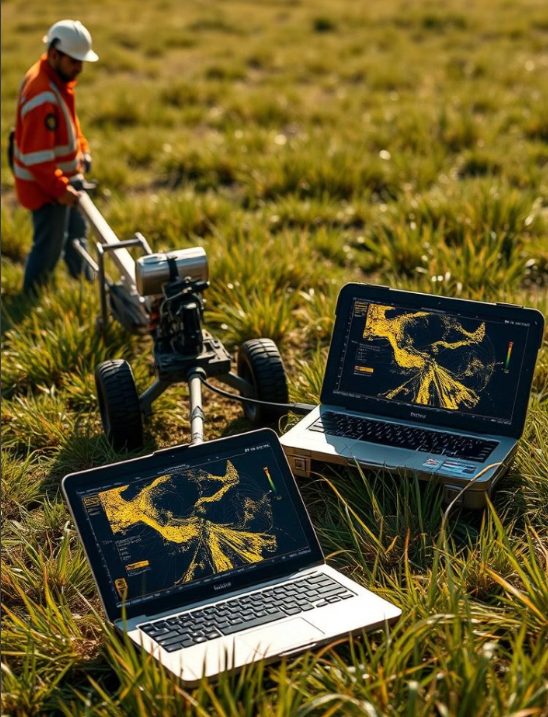GPR imaging for concrete
GPR imaging for concrete uses ground-penetrating radar technology to visualize and analyze the sub-surface structures in concrete. GPR imaging for concrete detects and maps features like rebar, post-tension cables, voids, and other embedded objects, helping engineers and construction professionals assess the condition and integrity of concrete structures.
As GPR imaging concrete imaging this tool used for non-destructive testing and evaluation of concrete structures. GPR works by transmitting electromagnetic waves into the ground or concrete and measuring the reflected signals that bounce back from various subsurface objects and features.
Here are some of the key functions and applications of GPR Imaging for concrete:
Locating Reinforcement: It can identify the location, depth, and orientation of reinforcing bars (rebar) within concrete structures, helping engineers and contractors understand the structural integrity.
- Detecting Voids: GPR can detect voids, gaps, or delaminations within the concrete, which could indicate deterioration or potential failure points.
- GPR Imaging Recognizes Utilities: By locating buried utilities, and conduits and pipes, before drilling or cutting into concrete to avoid damaging them.
- GPR Assesses Thickness: GPR can measure the thickness of concrete slabs and walls, providing valuable data for structural assessments.
- Evaluating Crack Patterns: The tool can help assess the extent and nature of cracks in concrete, which can inform repairs or maintenance needs.
- Mapping Inclusions: GPR can identify other inclusions within concrete structures, such as post-tension cables, etc.
GPR imaging for concrete help engineers and construction professionals make informed decisions on maintenance, renovation, and construction while minimizing disruption to structures.
Ground Penetrating Radar (GPR) is a non-destructive geophysical method that uses radar pulses to image the subsurface of concrete and other materials. A GPR concrete image provides visualization of the internal structures and features within concrete structures, such as:
- Reinforcement Bars (Rebar): GPR can detect and map the locations and depths of rebar within concrete, which is crucial for structural assessments and renovations.
- Post-Tensioning Cables: In post-tensioned concrete, GPR can help locate and assess the condition of these cables.
- Cracks and Voids: GPR can identify cracks, voids, and other anomalies that may compromise the integrity of the structure.
- Slabs and Joints: It can help assess the thickness of slabs, locate control joints, and identify any potential delamination or other issues.
- Utility Location: Utility Location: Operators use GPR to locate utilities embedded within or beneath concrete surfaces, which is necessary for construction and maintenance activities.
GPR imaging analyzes data to produce cross-sectional views of concrete, revealing internal features’ arrangement and condition. This vital information aids engineers and construction professionals in maintenance, repairs, and safety evaluations, while operators also use GPR to locate utilities within or beneath concrete surfaces.
GPR Imaging for Infrastructure Inspection
Ground penetrating radar imaging serves as a vital non-destructive evaluation (NDE) method for assessing various infrastructure components, from buildings to roads and railways. Recent advancements in GPR technology promise enhanced imaging capabilities, enabling better data visualization, analysis, and integration for informed decision-making in engineering.
The NDE objectives of GPR are threefold:
- Quality Assurance: Confirming structures comply with design specifications. Monitoring: Evaluating the condition of materials over time to preempt structural failures.
- As-Built Documentation: Creating accurate representations of existing conditions for modifications and future assessments.
- Despite its advantages, GPR’s output often lacks the clear, actionable data needed for engineering decisions. Established standards exist for certain applications, but a standardized approach for broader uses remains underdevelopment.
For successful GPR applications, two major elements must be addressed:
- Signal Interpretation: The transition from raw data to meaningful insights that inform engineering decisions.
- Standardization of Procedures: Engaging in systematic approaches to transform qualitative assessments into quantitative metrics.
GPR Imaging Conclusion
The continuous evolution of GPR technology, coupled with advanced computational capabilities, presents opportunities to enhance the application of GPR in infrastructure inspection.
In summary, while GPR imaging has made significant strides as an NDE tool, the journey toward optimizing its full potential in engineering decision-making continues, underscoring the importance of persistence in addressing existing challenges.

